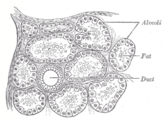Alveolar gland
| Alveolar gland | |
|---|---|
 | |
| Section of pancreas of dog. X 250. | |
| Code | TH H2.00.02.0.03028 |
If glands are categorized by shape, alveolar glands contrast with tubular glands. Alveolar glands have a saclike secretory portion, thus are also termed saccular glands. They typically have an enlarged lumen (cavity), hence the name similar to alveoli, the smallest air sacs in the lungs.
The term "tubulo-alveolar" (or "tubulo-acinar", or "compound tubulo-acinar", or "compound tubulo-alveolar"[1]) is used to describe glands that start out as branched tubular, and branch further to terminate in alveoli. This type of gland is found in the salivary glands,[2] esophagus,[3] and mammary glands.
Some sources draw a clear distinction between acinar and alveolar glands, based upon the size of the lumen.[4] A further complication in the case of the alveolar glands may occur in the form of still smaller saccular diverticuli growing out from the main sacculi.
The term "racemose gland"[5] is used to describe a "compound alveolar gland" or "compound acinar gland".[6]
Additional images
-

Alveoli of lacrimal gland.
-

Human submaxillary gland. At the right is a group of mucous alveoli, at the left a group of serous alveoli.
-

Section of portion of mamma.
-

Simple Branched Acinar Gland
-

Compound Tubulo-Acinar Gland
References
- ↑ Histology at KUMC glands-glands17
- ↑ Histology at KUMC glands-glands14 "Compound Tubulo- Alveolar"
- ↑ MedEd at Loyola histo/practical/epithelium/hp1-28.html
- ↑ Classification of Exocrine Glands
- ↑ Racemose+gland at eMedicine Dictionary
- ↑ SIU SOM Histology GI
| |||||||||||||||||||||||||||